Family : Acanthuridae

Text © Giuseppe Mazza

English translation by Mario Beltramini
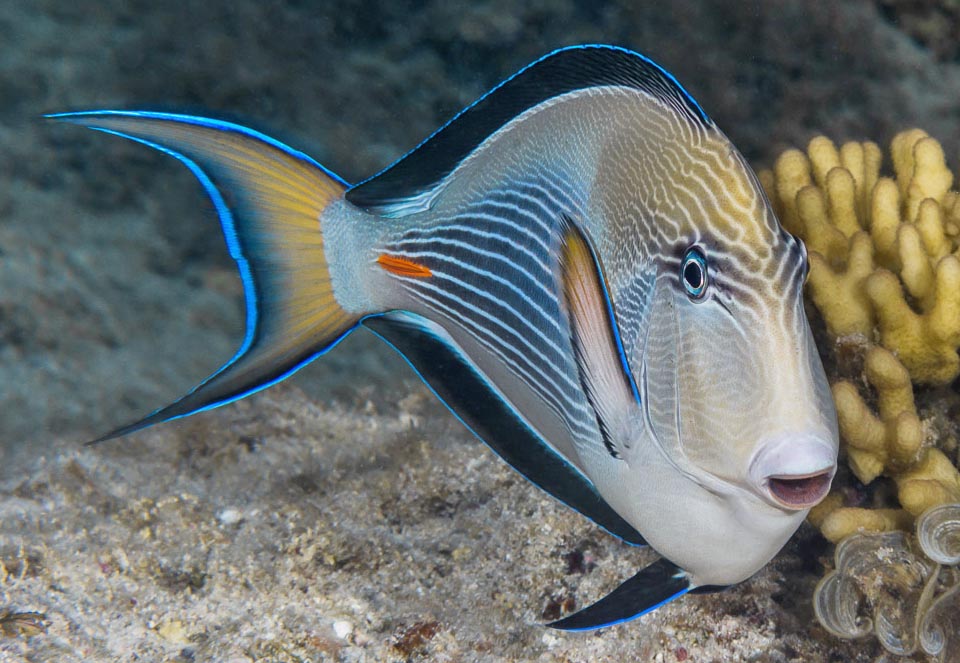
Even 40 cm long, The Red Sea clown surgeonfish (Acanthurus sohal) is present in the West Indian Ocean from the Red Sea to the Persian Gulf © François Libert
The Sohal surgeonfish (Acanthurus sohal Forsskål, 1775), belongs to the class of Actinopterygii, the ray-finned fishes, to the order of Perciformes and to the family of Acanthuridae.
The name of the genus “acanthurus”, come from the Greek “akantha”, spine, and “ura” = tail, because of the spine, sharp like a razor, these fishes do have on the tail.
The name of the species “sohal” is the name with which the Arabs call this fish.
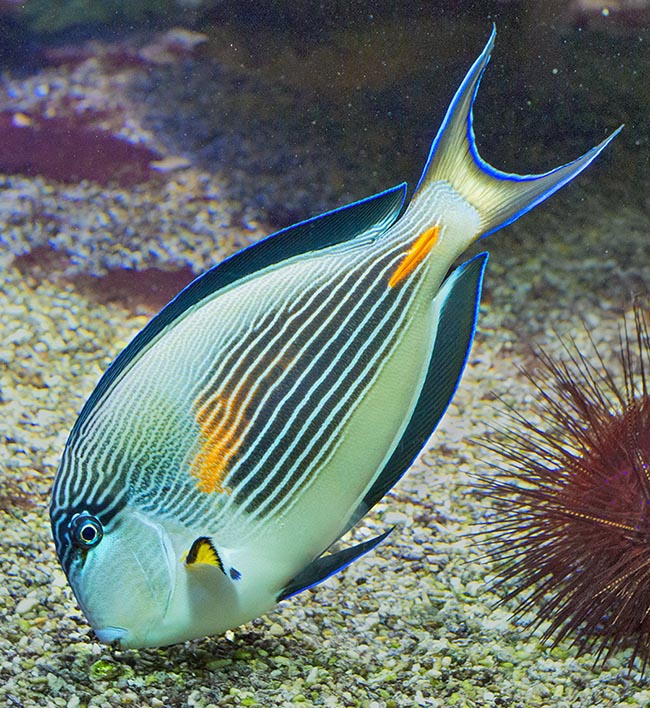
Eats seaweeds, especially the stringy ones or of the Sargassum genus, and the green film covering the bottoms © Giuseppe Mazza
Zoogeography
They often talk of it as a species endemic to the Red Sea, but actually, it is common in good part of the western Indian Ocean: in the Arabic Sea, in the Gulf of Aden and, as it seems, also up to the Seychelles and Madagascar.
Then, there is an interruption and we find it in the Pacific in Taiwan, where it appears to be native and not introduced, as is the case of Florida.
Ecology-Habitat
It lives in the madreporic formations, usually on the shelves and on the ridges, but never goes down under the 20 m of depth. It has a predilection for the Acropora corymbosa and Acropora pharaonis madrepores growing on the precipices, under which it shelters, well protected by their spikes, in case of danger.
Morpho-physiology
It can reach the 40 cm, but its average size stands around the 30 cm.
The body is flat, almost oval, with only one big dorsal fin with 8 spiny rays and about 39 soft rays. The anal is symmetrical but shorter, with 3 spines and about 32 unarmed rays; the ventral ones, of modest size, have 1 spine and 6 soft rays; the pectoral fins are relatively long and pointed; the caudal is decidedly crescent-shaped. In many ways it reminds the Acanthurus lineatus.
Also here many fins are edged of blue, but the intense yellow and blue stripes are missing. Here are rather horizontal bands almost black on a clear background with bluish reflections, tending to yellow only on the back. The belly is similar, without patterns, but these marmorize in the upper part of the body fading to become almost invisible on the operculum.
Only the zone near the eyes recovers, disguising it, the more marked tones of the drawing.
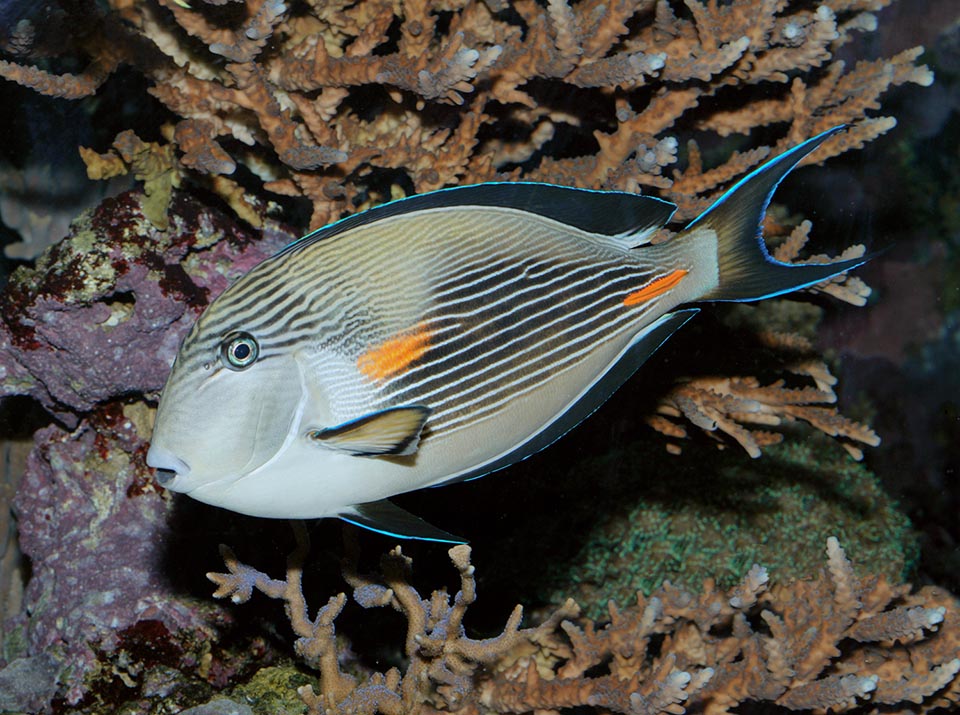
From the warning bright orange case of the caudal peduncle, gets out, when needed, a sharp blade to drive away with sharp lashes the aggressors and the intruders © Giuseppe Mazza
The cutting blade of the caudal peduncle, which in the Acanthurus lineatus was almost hidden, here is emphasized by the bright orange colour of the protective sheath, a clear sign of menace for the importunators, in a clearly aposematic context.
Another orange spot is present immediately after the pectoral fins by mid height of the body.
The mouth displays two flesh lips and tiny teeth.
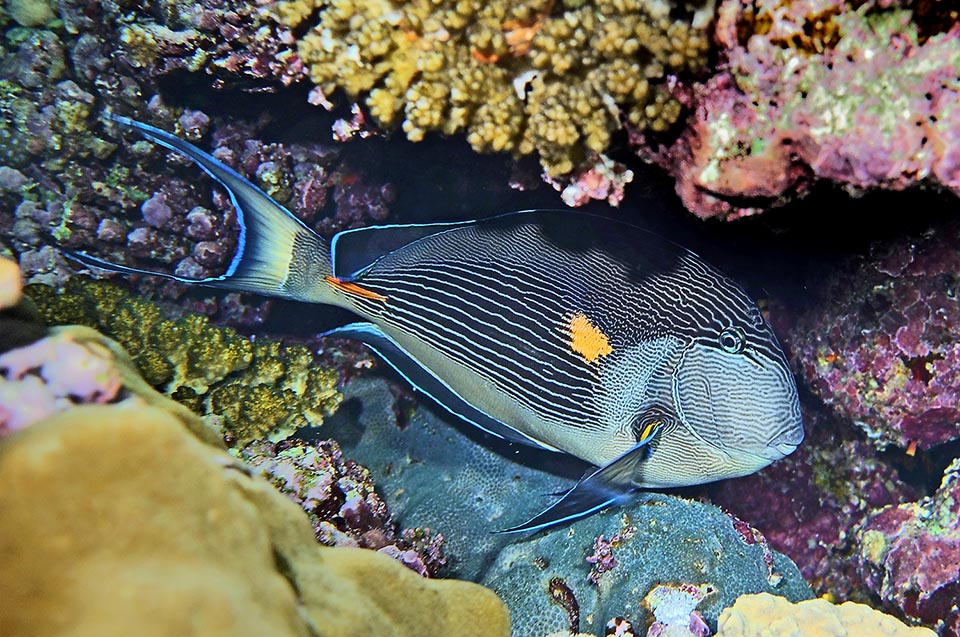
Majestic specimen. Fast swimmer knowing well how to extricate in the corals labyrinth, Red Sea clown surgeonfish is territorial and aggressive at times © Karine Marangon
Ethology-Reproductive Biology
The sohal surgeonfish is a fast swimmer capable to well extricate inside the labyrinth of corals. Territorial and often aggressive, it is found even in numerous groups exploring, restlessly, the rocks and the reef where they graze especially filamentous seaweeds or those belonging to the genus Sargassum, but nourish also of debris and of the pellicle of microscopic algae covering the bottom.
In aquarium it easily accepts food of animal origin, and it is therefore possible that in the wild it enriches often its diet with small crustaceans and other animals living among the seaweeds and the corals.
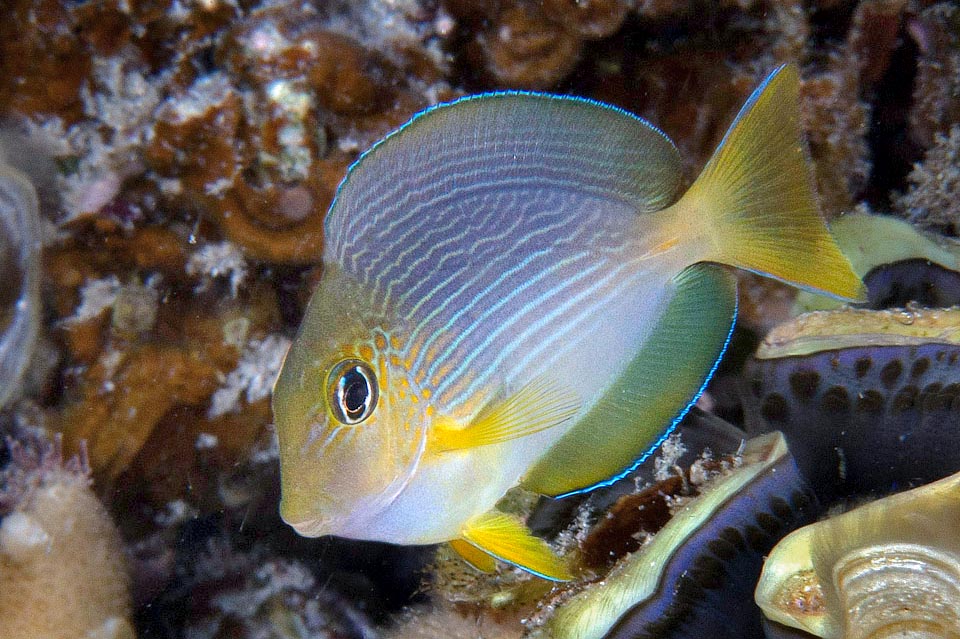
A juvenile with still roundish body, already displaying an outline of the adult livery and the typical blade of all the Acanthurus on its caudal peduncle © François Libert
The eggs are pelagic and after various larval stages, by the 2 cm of length, they gradually assume the shape of the adults.
Even if the flesh is not prized, it is consumed by the local populations and feeds the dreary trade of marine fishes for the domestic aquarium. However, the species is not endangered; it has a fishing vulnerability index of 30 on a scale of 100, with populations which can double in 1,4-4,4 years.
Synonyms
Acanthurus carinatus Bloch & Schneider, 1801; Chaetodon sohal Forsskål, 1775; Ctenodon ruppelii Swainson, 1839.
→ For general information about FISH please click here.
→ For general information about BONY FISH please click here
→ For general information about CARTILAGINOUS FISH please click here.
→ To appreciate the BIODIVERSITY of BONY FISH please click here.
→ To appreciate the BIODIVERSITY of CARTILAGINOUS FISH please click here.
